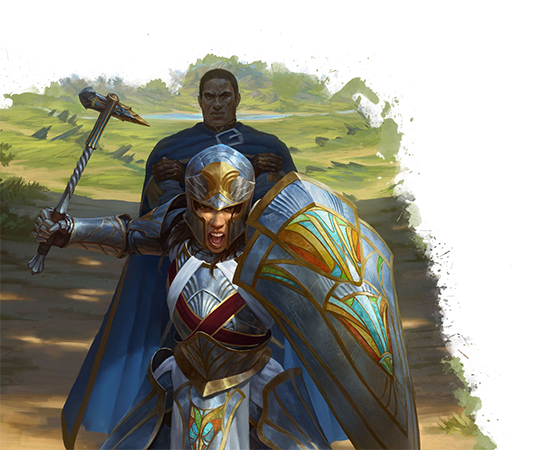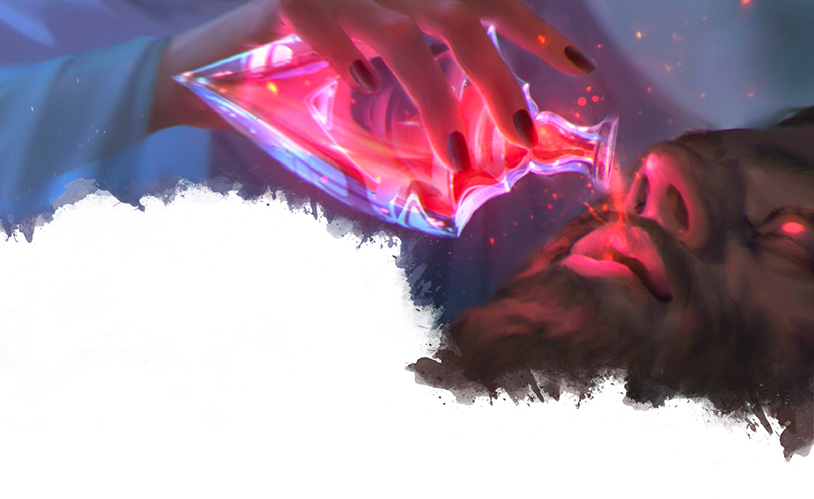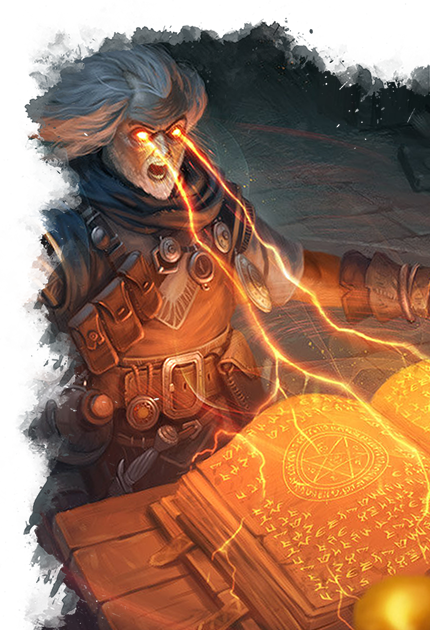Actions in Combat
When you take your action on your turn, the actions presented here are added to your list of options.
Breathe
When you take the Breathe action, you focus on your breath and calm your mind. If you are affected by any effects that allow you to make an Intelligence, Wisdom, or Charisma saving throw at the end of your turn to end the effect, you can make that saving throw as part of this action. If you fail the saving throw, you can still repeat the saving throw at the end of your turn.
Alternatively, you can grant yourself advantage on Intelligence, Wisdom, and Charisma saving throws until the start of your next turn. You lose this benefit if you are charmed, frightened, or incapacitated.
Interpose
You place yourself in danger to protect an ally. Choose a willing creature within your reach. Until the start of your next turn, any attacks made against that creature are instead made against you, provided you are within range of the attack and do not have total cover from the attacker. This effect ends if the creature takes this action or leaves your reach, or if you choose to end it or become incapacitated.
Thwart
You can impede another creature in the completion of a task. When you take the Thwart action, the creature you hinder suffers disadvantage on the next ability check it makes to perform the task you are impeding, provided that it makes the check within your reach and before the start of your next turn.
Alternatively, you can impede attacks against a creature. You distract the enemy, pull the target aside, or in some other way make incoming attacks less effective. The next attack roll made against the creature before the start of your next turn has disadvantage, provided they are within your reach when the attack is made.
Contests in Combat
The following rules provide ways of making combat more dynamic when creatures of different sizes do battle.
Throwing a Creature
While you are grappling a creature that is at least one size smaller than you, you can use the Attack action to make a special melee attack, a throw. If you're able to make multiple attacks with the Attack action, this attack replaces one of them. Instead of making an attack roll, you make a Strength (Athletics) check contested by the target’s Strength (Athletics) or Dexterity (Acrobatics) check (the target chooses the ability to use). If you win the contest, you can throw the creature up to 15 feet away from you in a direction you choose.
The maximum distance of a throw increases by 15 feet for each size smaller than you the target is. For example, a Medium creature could throw a Small target 15 feet, but a Large creature could throw a Small target 30 feet.
Size and Build
Creatures with abilties that cause them to count as one size larger for the purposes of determining how much they can push and lift also count as one size larger for the purposes of grappling, shoving, and throwing.
The Environment
The following rule expands on ways for adventurers and monsters to interact with the environment.
Impact
Magical effects or towering monsters may occasionally launch adventurers a great distance. If a creature is subjected to more than 20 feet of forced movement and the creature stops before that distance by impacting an obstacle or creature, it takes 1d6 bludgeoning damage for every 10 feet of movement remaining, to a maximum of 20d6. The creature then falls prone, unless it avoids taking damage from the impact. This damage is considered falling damage for the purposes of spells or abilities that interact with falling damage.
If a creature ends this movement early by colliding with a second creature and neither of them is Tiny, the second creature must make a DC 15 Dexterity saving throw or be impacted by the launched creature, and any damage resulting from the impact is divided evenly between them. The impacted creature is knocked prone, unless it is two or more sizes larger than the launched creature.
Optional Rules v 2.0 for D&D 5e
Created by: u/NotTheDreadPirate Art Credits: Manuel Castañón - Dauntless Bodyguard Pauline Voss - Potion of Healing Dmitry Burmak - Corrupted Signs These optional rules are used or referenced by some monsters, spells, or features visible on my GMBinder page.


Damage and Healing
The following rules provide the option for more perilous and exciting combat, and give players more freedom to experiment with features that grant overlapping benefits.
Exhausting Defeat
Being felled in battle can take a serious toll. When a creature falls unconscious as a result of having 0 hit points, they gain one level of exhaustion. If the creature dies, such as from failing death saving throws or being killed by the remaining damage, they gain one additional level of exhaustion.
If a dead creature has six levels of exhaustion, any effect that would raise them from the dead, such as the revivify spell, also reduces their level of exhaustion by one.
Potion Drinking
You can use a bonus action on your turn to drink a potion, and you can withdraw the potion from a pack, pouch, or other container as part of this bonus action. Administering a potion to another creature requires the Use an Object action.
If you use the Use an Object action to drink a potion of healing yourself, you roll twice as many dice when determining the number of hit points you regain.
Power Attacks
Before you make an attack with a weapon or unarmed strike as part of the Attack action on your turn, you can choose to take a -5 penalty to the attack roll. If the attack hits, you add +10 to the attack's damage.
Stacking Resistance
Creatures can gain resistance to different damage types through various means. If a creature has two or more sources of resistance to the same damage type, any damage of that type that they take is reduced by 5 for each instance of resistance they have beyond the first. This reduction is applied before the normal effects of resistance. For example, if a tiefling adventurer is holding a staff of fire and takes 25 points of fire damage from the breath weapon of a red dragon wyrmling, the damage would first be reduced by 5, becoming 20 points of damage, and then halved, becoming 10 points of damage. Resistance cannot reduce damage below 0.
If an effect would allow an instance of damage to bypass resistance to that damage type, only one instance of resistance is negated. If an effect causes a creature to gain vulnerability to a damage type that they have multiple sources of resistance to, the vulnerability and all resistances cancel each other out, causing the creature to take damage as if it had no sources of resistance or vulnerability to the damage.
Using Ability Scores
This section details rules that provide new uses for the Intelligence ability, and some that may make more character concepts possible to realize.
Spellcasting Ability
Many classes and subclasses in the game have the ability to cast spells, and each of these classes has a spellcasting ability that is used to determine the effectiveness of their magic.
However, these spellcasting abilities affect other aspects of the character, and you may find that the personality of the character and the ability scores necessary for their class or subclass do not align well.
In such cases, talk to your DM about changing the primary ability used by the class to a different ability, choosing from Intelligence, Wisdom, or Charisma. With your DM's permission, you can use this ability when determining your spell save DCs and spell attack roll modifiers, as well as in any other instance where the ability is referenced. Be sure to also change the ability used by class and subclass features, such as a paladin's Aura of Protection or a cleric's Potent Spellcasting.
In some cases, you may also want to change the saving throw proficiencies granted by your class to reflect these changes. Be sure that your character has one proficiency from Strength, Intelligence, or Charisma, and another proficiency from Dexterity, Constitution, or Wisdom. This ensures that your character will have the appropriate levels of resistance to various harmful effects.
This process can also be done for classes or subclasses that do not have spells, but still rely heavily on Intelligence, Wisdom, or Charisma, such as the monk class or the psi knight fighter archetype. Again, remember to work with your DM to determine whether and how to adjust anything about your character's class or subclass.
Intelligence
Intelligence measures not only your ability to recall information and reason, but is also an approximation of the information your character has accumulated through study. These rules expand the uses for the Intelligence ability.
Acquired Knowledge
When you create your character, you gain a number of Knowledge Points (KP) equal to your Intelligence modifier (minimum 0). You can spend these Knowledge Points as you wish while creating your character to gain certain benefits, as shown in the Acquired Knowledge table below.
Acquired Knowledge
| KP Cost | Benefit | Prerequisite |
|---|---|---|
| 1 | Proficiency with one skill, tool, language, or vehicle of your choice. | — |
| 1 | Proficiency with three simple weapons of your choice, or one martial weapon of your choice. | — |
| 1 | Proficiency with improvised weapons. | Strength or Dexterity 13 or higher. |
| 2 | Proficiency with three martial weapons of your choice. | — |
| 2 | Proficiency in Strength or Intelligence saving throws. | — |
| 2 | Proficiency with light armor. | Dexterity 15 or higher. |
| 2 | Proficiency with medium armor. | Proficiency with light armor. |
| 2 | Proficiency with shields. | Proficiency with medium or heavy armor. |
| 3 | You learn one cantrip of your choice. Intelligence is your spellcasting ability for it. | — |
| 3 | Proficiency in Wisdom or Dexterity saving throws. | — |
| 3 | Proficiency with heavy armor. | Proficiency with medium armor. |
| 3 | Expertise with one skill, which means your proficiency bonus is doubled for any ability check you make with it. The skill can't be one benefiting from a feature, such as Expertise, that doubles your proficiency bonus. | Proficiency with the chosen skill. |
If your Intelligence modifier permanently increases, you gain additional Knowledge Points as appropriate. Whenever you gain the Ability Score Improvement feature, you can redistribute or spend any KP you have as you wish.
Spell Scrolls
Any creature that speaks at least one language can attempt to cast the spell contained in a spell scroll. Casting a spell from a scroll has two steps.
First, you must determine what spell is written on the scroll if you do not know it already, such as through the identify spell. If the spell is on your class or subclass spell list, you can learn it simply by reading the scroll. If the spell is not on your spell list, you can make an Arcana check to determine which spell is written on the scroll. The DC equals 10 + the spell's level. If you do not have the ability to cast spells, you have disadvantage on this check.
Second, once you know the spell that is on the scroll, you can attempt to cast it. If the spell is on your class or subclass spell list and is of a level you can normally cast, you can do so without issue. Otherwise, you can make an Arcana check to determine whether you cast it successfully. The DC equals 10 + the spell's level. If the spell is on your spell list or of a level you can cast, you have advantage on the ability check. If you cannot cast spells, you have disadvantage on the ability check. If you can cast spells, you can use your spellcasting ability modifier, instead of Intelligence, for the Arcana check to cast the spell.
As usual, the words on the scroll fade after a creature attempts to cast the spell from it, whether the attempt succeeds or fails, as long as it is not interrupted.
